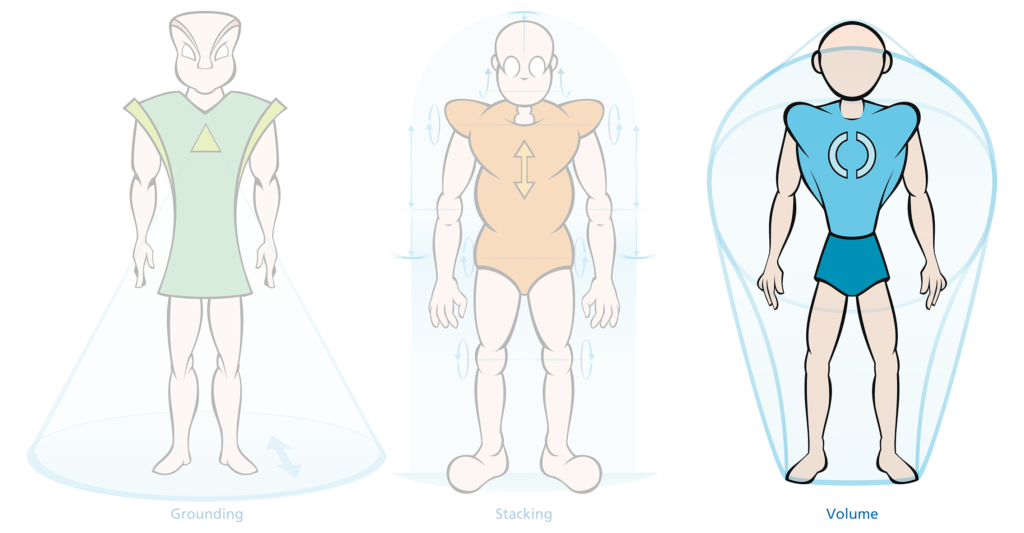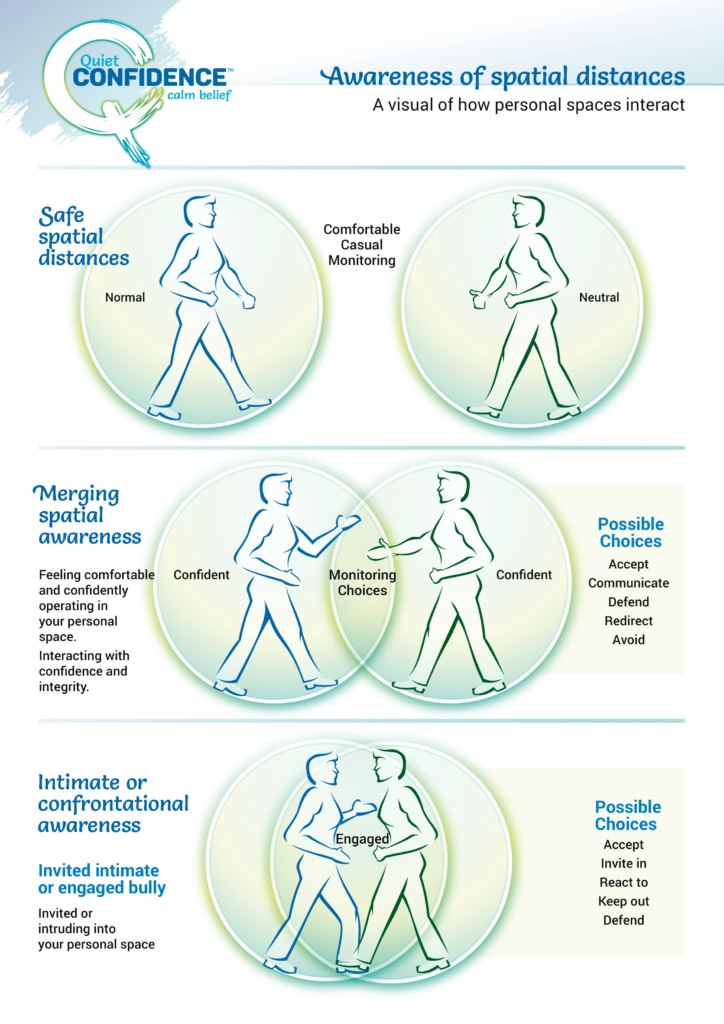In this introductory series, we cover the principles of Quiet Confidence – the 3 pillars:
- Grounding & Stability
- Stacking
- Volume (Personal Space)
These 3 pillars are the 3 guiding principles that help develop awareness in your own body, as well as allow you to control how you feel in your body and therefore parts of your subconscious, and ultimately to feel fully safe and secure within your own body and space.
Here, we are going to cover volume or personal space, the final fundamental component in feeling the space around you.
What is Volume?
Finding your volume is the third component we use within Quiet Confidence. Most of us at some stage have been told about our personal space, yet we still never get a chance to experience or explore it. It is an invisible thing that we think we understand, but not sure how to connect to.
In science, it is referred to as our Peri-Personal space – the area around us that our subconscious has already mapped out and is connected to, even though we are unaware of this in our conscious mind. This is why sometimes we can feel things near us, even though we can’t see them.
This includes connecting to an object, where our subconscious expands to include that object. For example, when we hop into our car and have been driving for a long time, you become automatically adjust to the size and volume of the vehicle, and that enables you to feel safe and comfortable to drive it. Or, when you use a hammer or pen, these tools literally become part of the body, or an extension of the body, shown in much scientific research to be true.

The Scientific Peri personal space
In order to prove that all this isn’t just some spiritual mumbo jumbo, below I have outlined the scientific counterpart to this concept, peri personal space.
In psychology, the peri personal space (PPS) is the space immediately surrounding the body, within arm’s reach. It is the area that is within easy reach of our limbs and senses. PPS is responsible for the processing of tactile and proprioceptive (meaning the sense of where our body parts are) information, allowing for the appropriate motor response and perception of the body in relation to the environment.
PPS plays an important role in our ability to interact with objects in our immediate environment, such as grasping and manipulating objects.
PPS is also thought to be closely related to the concept of body schema, which refers to our internal representation of our body and its movements. Research has shown that the PPS is not fixed, but can be modulated by attention, action, and the presence of objects in the environment.
The levels of personal space
Personal space can be divided into four zones:
- Intimate: This is the space closest to a person, usually reserved for family, close friends, and loved ones. It typically extends from the person’s body to about 45 cm (18 inches) away.
- Personal: This is the space just beyond the intimate zone, usually reserved for friends and acquaintances. It typically extends from 45 cm to about 1.2 m (4 feet) away.
- Social: This is the space for more formal interactions, such as at work or in public settings. It typically extends from 1.2 m to about 3.7 m (12 feet) away.
- Public: This is the space for interactions in large groups or public settings, such as on a stage or in a lecture hall.
Why do we need Volume?
Your volume is the space you have the right to be in and belongs to you. You have the right to choose who you invite in or keep out of your volume.
Being aware of your volume allows you the opportunity to make these choices.
Your volume is adjusting all the time depending on many factors that are occurring, such as emotions, events happening around you, thoughts in your mind, etc. If you are feeling sad or down you don’t have much volume, and when you are happy or excited you have more volume, so your volume is in a constant state of flux.
Awareness of our volume allows us the opportunity to connect to it. By connecting to our volume, our structure and our grounding we become a fuller person, and finally creates the feeling of calm contentment.
Most people are unaware of their Volume
Just as people have now become accustomed to unnatural and compromised structures (not enough grounding on their feet and a tight structure), this naturally leads to having less volume than desired, as volume is also an extension of the other two pillars.
This further means that it is easy for others to enter and compromise your personal space, and in turn control it or threaten you with it as well. That is, with smaller volume, it becomes easier to dominate that space. This is when, for example, a bully forces their way into your personal or even your intimate space.

Fight or flight response
This, again, feeds into the fight or flight response that has been so significant in the previous two pillars.
In flight mode, people want to appear smaller, so they compress their structure and bring in their shoulders and arms. This compression of structure also compresses our volume too, in order to make us appear smaller and not so much of a threat to others.
On the other hand in fight mode, people want to appear larger, so they try and overextend their structure and puff out their chest or arms. This creates an unnatural expansion of structure, which also overextends our volume too, in order to make us appear larger and more of a threat to others. It’s similar to how cats will puff out their hairs to look bigger and more threatening (and humans do this too with goosebumps!)
Of course, there’s a difference to overextending volume and expanding volume. That is, volume must be built on a solid framework – good grounding and structure – in order for it to be effective. However, building volume on compromised structure is simply the same as building a house on a faulty foundation – the resulting overall structure is dangerously close to toppling over at any moment.
How to discover your volume in the first place
In order to begin to be aware of our volume, we must first acknowledge the fact that we are unaware of it, just as we have for grounding and structure. I would also recommend checking out the exercises from those 2 posts as well, before incorporating this one.
The following exploration method is best for beginners, and will lead you to learn more about yourself and how you hold your own body.
How to monitor your volume
Stand with your feet shoulder width apart. Swing your arms freely up and down in front of you. At some point allow them to stop and have a look at them. This is an indication of your volume at this point and time.
Examples of where your arms are:
- If your elbows are locked and your arms are reaching out: This indicates that you are trying to keep something out for you to feel safe. It also means that you may be a little uncomfortable within yourself.
- If your arms have collapsed at the elbows and are close to your body: This indicates that you have little volume and are not confident within yourself.
- If your elbows are slightly bent but not collapsed and without over reaching (and it feels comfortable to hold them there): Then you have a good amount of volume.
This is a rough indication of the volume you hold. You can find your volume area if you rotate to the left and rotate to the right as far as you can comfortably turn, and if you rotate your arms upwards over your head. All this area is your personal space in which you have the right to be in.
By being able to connect to your volume you can use this to your advantage in multiple situations. However, for now, we will leave you with this basic exploration technique and we’ll explore this more in future exercises.
How this feeds into the bigger picture
And with that, we have covered the all three of the 3 pillars of Quiet Confidence.
As mentioned before covered in this series is:
- Grounding and stability – how we feel on our feet (found here)
- Stacking – carrying ourselves with structure (found here)
- Volume – personal space that you have a right to live in this post!)
Again, remember the order of these 3 pillars are such because of the following:
Without grounding you cannot have stacking, and without stacking you cannot have volume.
All three are needed in order to be fully aware of our body and the space around it – once we are aware, it will allow you to stay calm throughout the day and most situations that approach you. This also allows you to portray an aura of confidence while minimizing ego and aggression, which is the essence of Quiet Confidence.
Volume is the third and final pillar, as stated before, when pouring water into a vessel, the water will take the shape of the vessel, and therefore it’s important to make sure that the vessel itself is strong and is able to keep its shape with water.
As a final note, I would like to remind you that while these 3 concepts may be the most boring or mundane, these are also the most fundamental and important concepts to all other aspects of our life, making them vital to fully understand despite how boring it may seem.
What’s Next?
Now that we have covered the very fundamentals of Quiet Confidence, it’s time to delve into some deeper stuff! I would recommend continuing to practice all three exercises for each pillar regularly, as they’ll prove to be invaluable in building the foundation that all other exercises will build off.
That being said, now you can stay tuned for more advanced techniques and deeper insights to the philosophy of Quiet Confidence.
Have fun exploring!
2 Comments
The 3 Pillars of Quiet Confidence - Stacking
26 Feb 2023 - 3:02 am[…] The 3 Pillars of Quiet Confidence – Pillar 1: Grounding & Stability Jan 29, 2023 The 3 Pillars of Quiet Confidence – Pillar 3: Volume (Personal Space) Feb 16, 2023 […]
The First Pillar: Grounding & Stability - Quiet Confidence
26 Feb 2023 - 3:02 am[…] Volume (Personal Space) […]